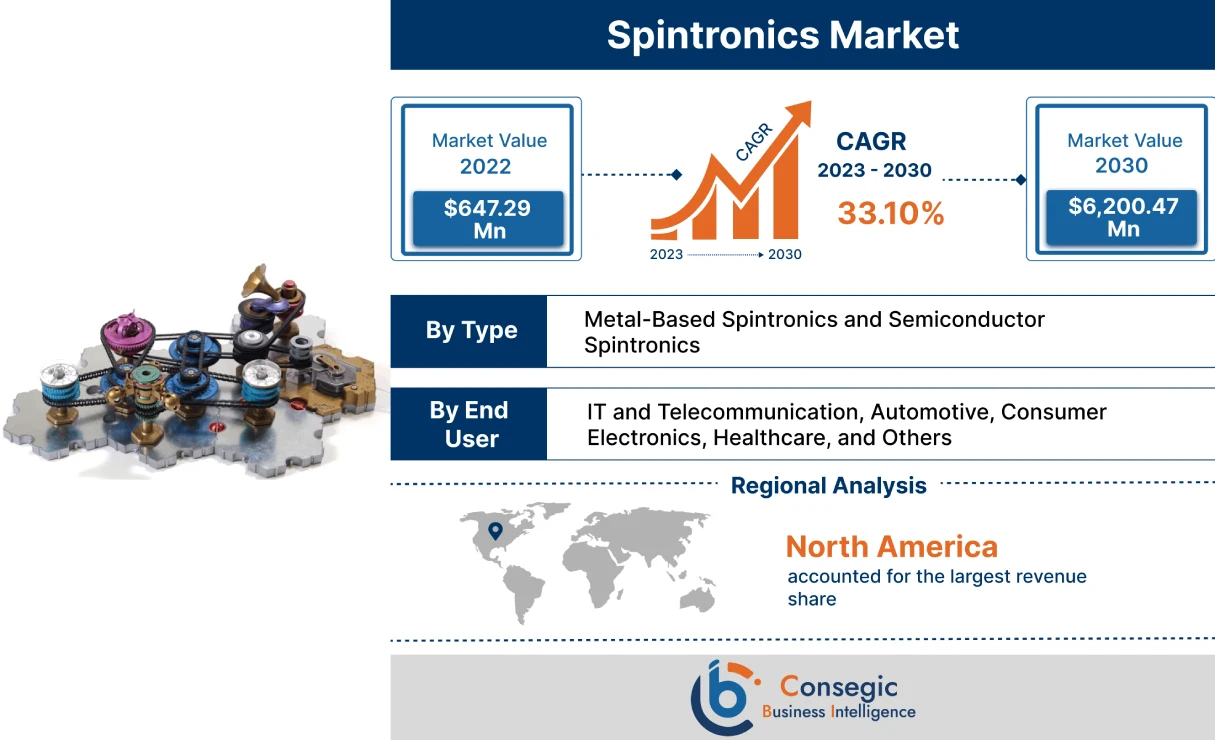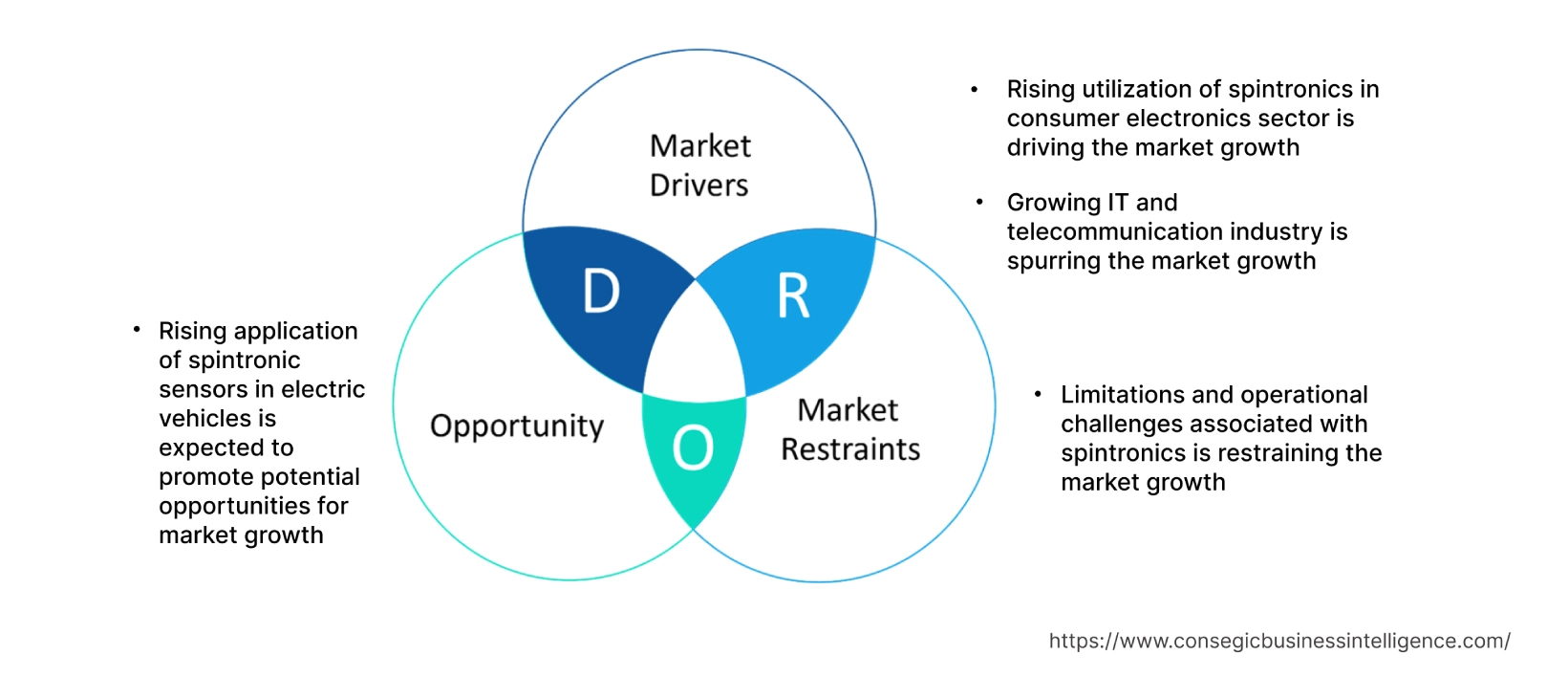- Summary
- Table Of Content
- Methodology
Spintronics Market Size :
Global Spintronics Market size is estimated to reach over USD 6,200.47 Million by 2030 from a value of USD 647.29 Million in 2022, growing at a CAGR of 33.10% from 2023 to 2030.
Spintronics Market Scope & Overview:
Spintronics or spin electronics refers to an emerging solid-state device technology that utilizes the inherent spin properties of an electron and its associated magnetic moment, in addition to the electron charge. Spintronic devices offer a range of benefits including lower power consumption, higher performance, and increased integration density in comparison to traditional electronic devices. The aforementioned benefits of spintronic devices are key determinants for increasing its deployment in IT and telecommunication, automotive, consumer electronics, healthcare, and other industries.
Spintronics Market Insights :
Key Drivers :
Rising utilization in consumer electronics sector
Spintronics utilizes the spin degree of freedom for injecting, transporting, and detecting information in electronic devices. They are primarily used in electronics sector, particularly in hard drives for data storage applications. Moreover, They offer higher performance with lower power consumption while reducing the effort required to perform computational or memory functions. Their above features are increasing its adoption in consumer electronics sector.
Factors including advancements in consumer electronics including artificial intelligence (AI) and internet of things (IoT), rising penetration of smartphones, computers, and other consumer devices, and increasing demand for energy-efficient and smart devices are driving the proliferation of the electronics sector.
According to Japan Electronics and Information Technology, the total production by the Japanese electronics sector reached USD 95.2 billion in 2021, witnessing a rise of 9.9% in comparison to 2020. Analysis of market trends concludes that the growing electronics sector is driving the utilization of spin electronics for data storage and computational applications, in turn driving the spintronics market demand.
Growing IT and telecommunication sector
The IT and telecommunications sector is highly dependent on data transmission and storage applications. Spintronic devices are used in the IT and telecommunication sector to facilitate faster and reliable data transmission, storage, and communication applications, attributing to its increased speed, higher efficiency, and enhanced data storage capabilities.
Factors including the growing penetration of 5G infrastructure, increasing demand for wireless communication, and rising adoption of smartphones and communication devices are among the primary determinants for driving the growth of the telecommunication sector.
For instance, according to the Ookla 5G Map, 5G deployments reached 112 countries in November 2021, witnessing an increase of 13% as compared to 99 countries in November 2020. Ookla further states that the overall number of 5G deployments increased considerably and reached up to 85,602 deployments in 2021 in comparison to 17,428 deployments in 2020. Analysis of market trends concludes that the rising penetration of 5G networks along with the proliferation of telecommunication sector is increasing the adoption of spintronic devices for faster and reliable data transmission and communication applications, in proliferating driving the growth of the market.
Key Restraints :
Limitations and operational challenges
The utilization of spintronics is usually associated with few limitations and operational challenges, which is a key factor limiting the market expansion.
Analysis of market trends concludes that spintronic devices are often associated with difficulties in controlling the spin for long distances and combining techniques between the semiconductor and magnetic recording, which in turn hampers its performance.
Additionally, the transportation of spin polarized carriers across appropriate length scales and manipulation of nuclear and electron spins on sufficiently fast time scales are among the major challenges faced by the utilization of spin electronics technology. Therefore, the aforementioned limitations and operational challenges associated with it are constraining the expansion of the market.
Future Opportunities :
Rising application of spintronic sensors in electric vehicles
The rising application of spintronic sensors in electric vehicles is expected to present potential opportunities for the proliferation of the spintronics market. Spintronic sensors are used in electric vehicles to enhance its battery performance and improve vehicle range in EVs. Moreover, spintronic sensors have the ability to provide information on current, vehicle speed, vehicle detection, and other related parameters, making it ideal for utilization in the advanced driver-assistance system (ADAS) in electric vehicles.
Factors including the availability of broad range of models, eco-friendliness, along with the availability of subsidies and tax rebates are driving the expansion of electric vehicles industry.
According to the International Energy Agency (IEA), the worldwide adoption of electric cars witnessed considerable increase in 2022. According to IEA, the global sales of electric vehicles reached up to 2 million units in the first quarter of 2022, depicting an increase of 75% in comparison to the first quarter of 2021. Analysis of market trends concludes that the rising adoption of electric vehicles is projected to increase the integration of spintronic sensors in EVs, in turn is emerging as one of many spintronics market opportunities that will drive market expansion during the forecast period.
Spintronics Market Report Insights :
| Report Attributes | Report Details |
| Study Timeline | 2017-2030 |
| Market Size in 2030 | USD 6,200.47 Million |
| CAGR (2023-2030) | 33.10% |
| By Type | Metal-Based Spintronics and Semiconductor Spintronics |
| By End-User | IT and Telecommunication, Automotive, Consumer Electronics, Healthcare, and Others |
| By Region | North America, Europe, Asia-Pacific, Latin America, and Middle East & Africa |
| Key Players | Avalanche Technology, NVE Corporation, Everspin Technologies Inc., Crocus Technology Inc., Qnami, Synopsys Inc., TDK Corporation |
| Geographies Covered | |
| North America | U.S. Canada Mexico |
| Europe | U.K. Germany France Spain Italy Russia Benelux Rest of Europe |
| APAC | China South Korea Japan India Australia ASEAN Rest of Asia-Pacific |
| Middle East and Africa | GCC Turkey South Africa Rest of MEA |
| LATAM | Brazil Argentina Chile Rest of LATAM |
| Report Coverage | Revenue Forecast, Competitive Landscape, Growth Factors, Restraint or Challenges, Opportunities, Environment & Regulatory Landscape, PESTLE Analysis, PORTER Analysis, Key Technology Landscape, Value Chain Analysis, Cost Analysis, and Regional Trends & Forecast |
Spintronics Market Segmental Analysis :
By Type :
Based on the type, the market is bifurcated into metal-based and semiconductor. In 2022, the semiconductor segment accounted for the highest spintronics market share. Semiconductor spintronics comprise of doped semiconductors that depict dilute ferromagnetism. They involve a combination of photonics and magnetics which includes several functional devices such as spin-LEDs, spin-transistors, memory devices, and optical switches among others. Moreover, semiconductor spintronic devices offer various benefits including high speed, efficiency, infinite endurance, and excellent data storage capabilities. The above benefits of semiconductor spintronic devices are increasing its application in IT & telecommunication, automotive, and healthcare sectors among others.
According to Viavi Solutions Inc., the total number of cities with 5G networks reached 1,947 worldwide as of January 2022, with the addition of 635 new 5G cities in 2021. Analysis of market trends concludes that the proliferation of telecommunication sector is among the key factors driving the adoption of semiconductor spin electronics for faster and reliable data transmission and communication applications, in turn contributing to the expansion of the market.
The metal-based segment is anticipated to register fastest CAGR growth during the forecast period. Metal-based spintronics is a primarily utilized in hard disk storage among others. In them, a large magnetoresistance tunnel consisting of two ferromagnetic plates with one fixed and one movable plate, are divided by a thin insulating layer. The layers in them are further aligned to lower the electric resistance while flowing spinning electrons. Moreover, they offer several benefits including low power consumption, zero standby leakage, good read and write performance, and others. The above benefits of metal-based segment make it ideal for utilization in consumer electronics, and other industries.
For instance, according to the Association of German Banks, the electronics sector in Germany witnessed a substantial increase in 2021. The production and nominal sales of electronics sector increased by 10% in 2021 as compared to 2020. Analysis of market trends concludes that the expansion of electronics sector is anticipated to drive the adoption of metal-based spin electronics, in turn fostering spintronics market growth during the forecast period.
By End-User :
Based on the end-user, the market is segregated into IT and telecommunication, automotive, consumer electronics, healthcare, and others. The consumer electronics segment accounted for the largest revenue share of 35.4% in the year 2022. Factors including advancements in consumer electronics including artificial intelligence (AI) and internet of things (IoT), penetration of smartphones, computers, and other consumer devices, and increasing demand for energy-efficient and smart devices are driving the proliferation of the consumer electronics segment.
For instance, according to the Brazilian Electrical and Electronics Industry Association (ABINEE), the electrical and electronics sector in Brazil was valued at USD 42.2 billion in 2022, witnessing an increase of nearly 8% in comparison to USD 39.2 billion in 2021. Analysis of market trends concludes that the growing electronics sector is driving the adoption of spin electronics for data storage and computational applications, in turn proliferating the expansion of the market.
IT and telecommunication segment is expected to witness fastest CAGR growth during the forecast period. It is attributed to several factors including the growing penetration of 5G infrastructure, increasing demand for faster wireless communication, along with rising need for high-speed data and cloud-based services.
For instance, according to GSM Association, majority of countries in Europe deployed commercial 5G services in 2021, and approximately two thirds of operators in the region launched 5G networks. GSM Association also states that 5G connections across Europe are projected to reach 311 million by 2025. Thus, the proliferation of IT and telecommunication sector is projected to drive the adoption of spintronic devices for faster data transmission and communication applications, in turn driving the market expansion during the forecast period.
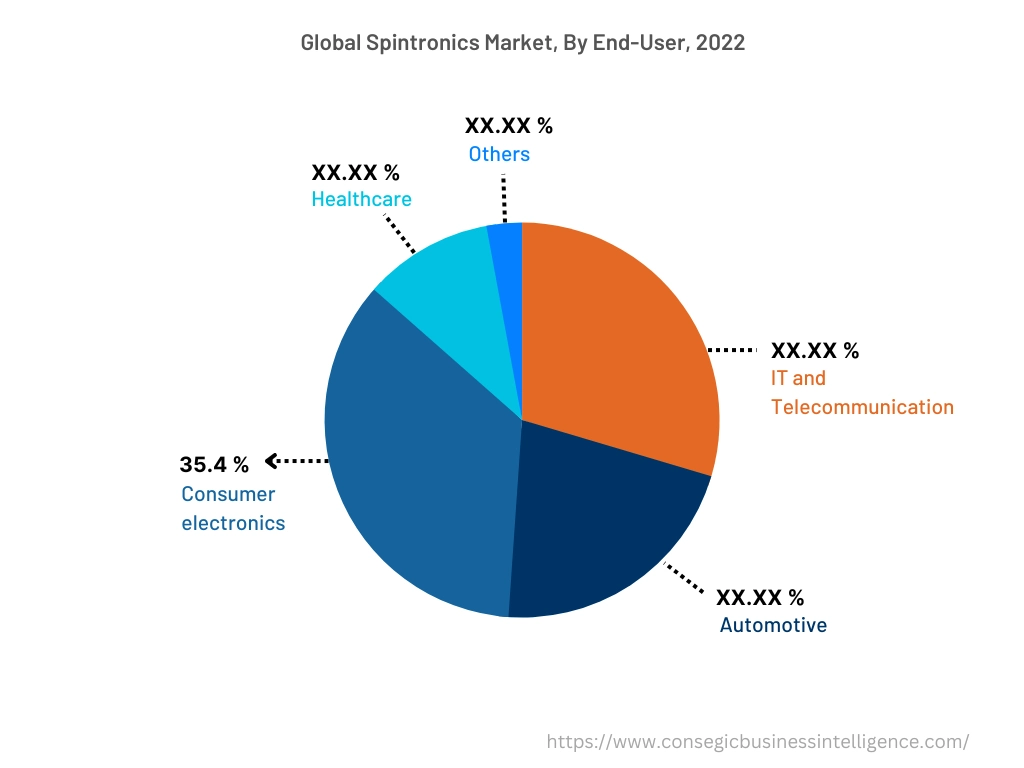
By Region :
The regional segment includes North America, Europe, Asia Pacific, Middle East and Africa, and Latin America.
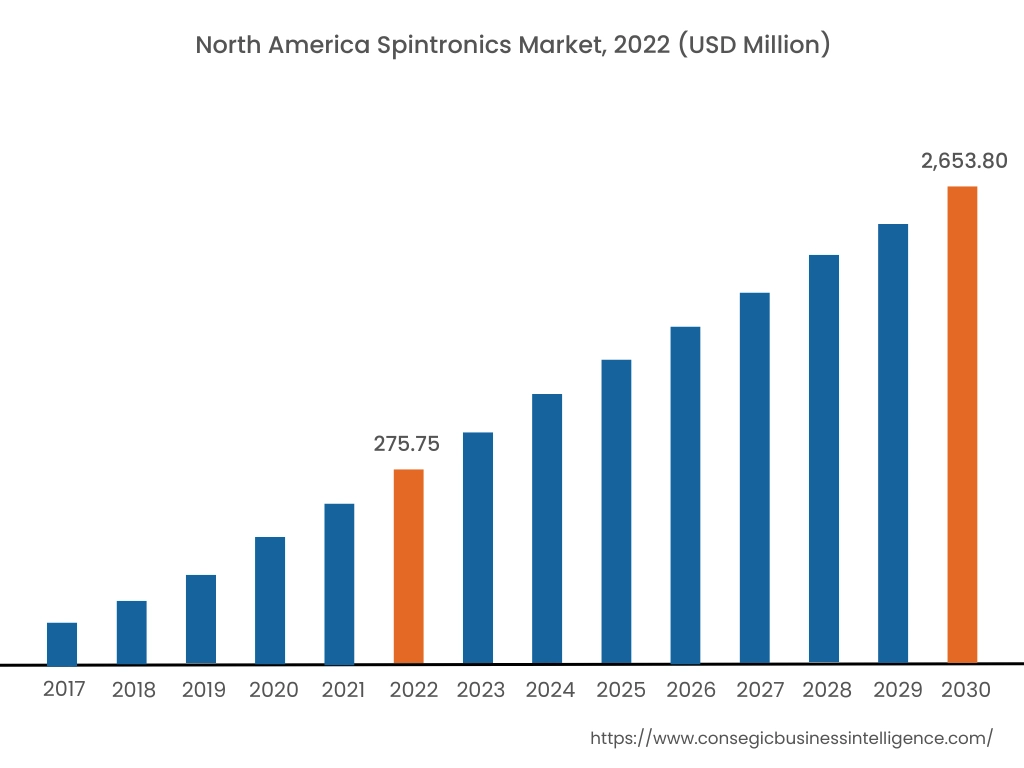
North America accounted for the largest revenue share of USD 275.75 Million in 2022 and is expected to reach USD 2,653.80 Million by 2030, registering a CAGR of 33.2% during the forecast period. In addition, in the region, the U.S. accounted for the maximum revenue share of 64.5% in the same year. The adoption of spin electronics in the North American region is mostly driven by its utilization in IT & telecommunication, automotive, healthcare, and other sectors. Moreover, the increasing utilization of spintronic devices in telecommunication infrastructure for faster data transmission and communication is among the significant factors driving the market expansion in the region. For instance, according to the GSM Association, approximately 140 million 5G connections were deployed across North America as of 2022. Analysis of spintronics market trends concludes that the growing telecommunication sector is propelling the deployment of spintronic devices for high speed data transfer and communication applications, in turn fostering market grow proliferation in the North American region. Additionally, increasing investments in the electric vehicles and healthcare industries are anticipated to promote lucrative growth aspects for the market in North America during the forecast period.
Asia-Pacific is expected to register fastest CAGR growth of 33.4% during the forecast period. The growing pace of industrialization and development is creating lucrative growth aspects for the market in the region. Additionally, factors including the development of multiple industries such as automotive, consumer electronics, IT & telecommunication, and others are fostering the market expansion for spintronic in the Asia-Pacific region.
For instance, according to the Society of Indian Automobile Manufacturers, the overall automobile production in India reached 2,59,31,867 units from April 2022 to March 2023, depicting an incline of 12.6% from 2,30,40,066 units from April 2021 to March 2022. The spintronics market analysis concluded that the growing automotive sector is anticipated to drive the utilization of spintronic sensors for deployment in automobile advanced driver-assistance system, attributing its ability to provide information on vehicle speed, vehicle detection, and other related parameters. The above factors are projected to drive market proliferation in the Asia-Pacific region during the forecast period.
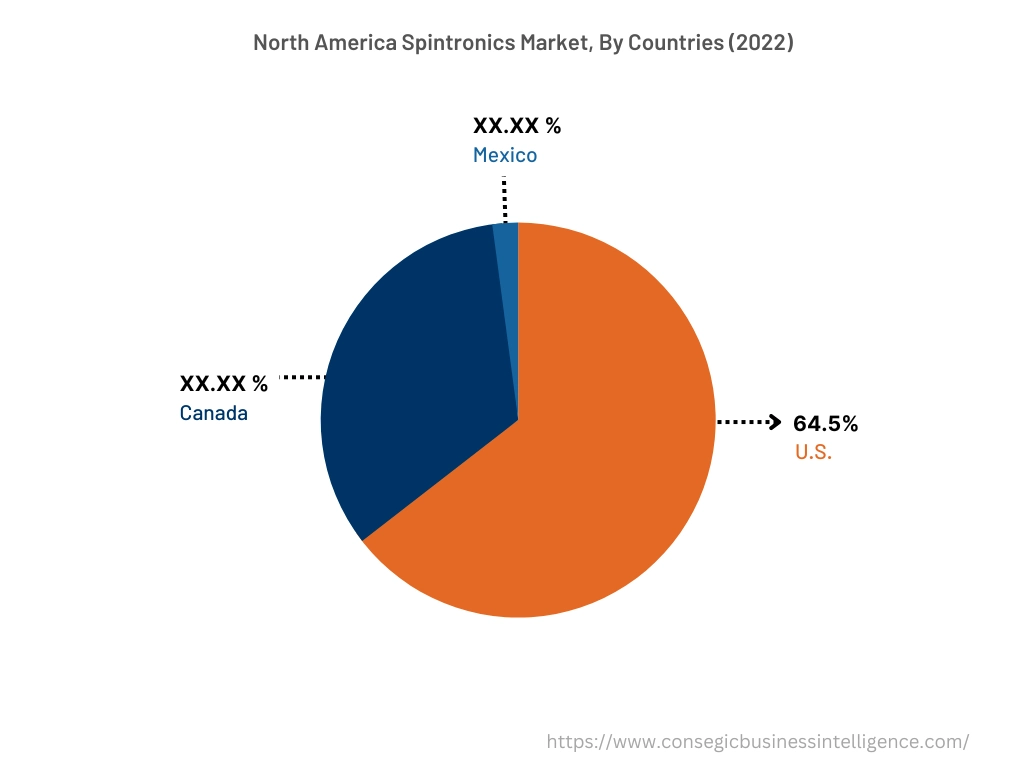
Top Key Players & Market Share Insights :
The spintronics market is highly competitive with major players providing products to the national and international markets. The major companies operating in the spintronics industry are adopting several strategies in research and development (R&D), product innovation, and application launches to hold a strong position in spintronics market. Key players in the spintronics market include-
- Avalanche Technology
- NVE Corporation
- Synopsys Inc.
- TDK Corporation
- Everspin Technologies Inc.
- Crocus Technology Inc.
- Qnami
Recent Industry Developments :
- In November 2022, Everspin Technologies Inc. launched its high-density STT-MRAM (spin-transfer torque magnetic random-access memory) product series. The STT-MRAM series is designed for utilization in a range of applications including network/enterprise infrastructure, IoT (Internet of Things), aeronautics/avionics, medical, and other applications.
Key Questions Answered in the Report
What is spintronics? +
Spintronics refers to an emerging solid-state device technology that utilizes the inherent spin properties of an electron and its associated magnetic moment, in addition to the electron charge.
What specific segmentation details are covered in the spintronics report, and how is the dominating segment impacting the market growth? +
For instance, by type segment has witnessed semiconductor spintronics as the dominating segment in the year 2022, owing to its increasing utilization in IT & telecommunication, automotive, and healthcare sectors among others.
What specific segmentation details are covered in the spintronics market report, and how is the fastest segment anticipated to impact the market growth? +
For instance, by end-user segment has witnessed IT and telecommunication as the fastest-growing segment during the forecast period due to the rising adoption of spintronic devices in telecommunication sector for faster data transmission and communication applications.
Which region/country is anticipated to witness the highest CAGR during the forecast period, 2023-2030? +
Asia-Pacific is anticipated to register fastest CAGR growth of 33.4% during the forecast period due to rapid pace of industrialization and growth of multiple industries such as automotive, consumer electronics, IT & telecommunication, and others.
